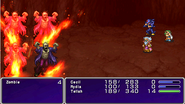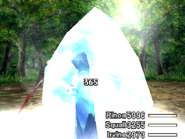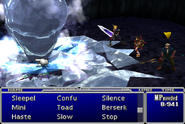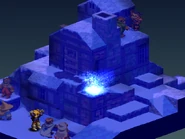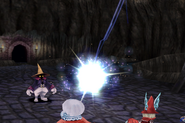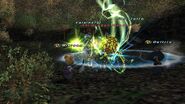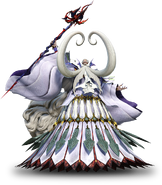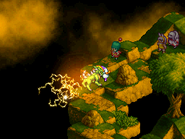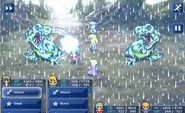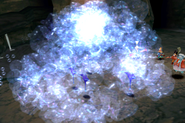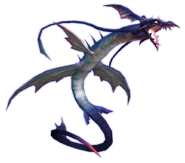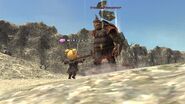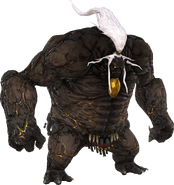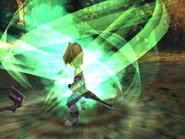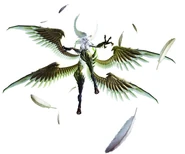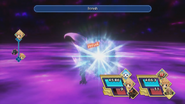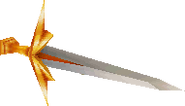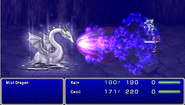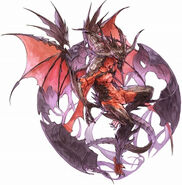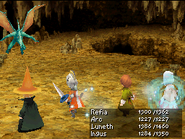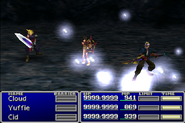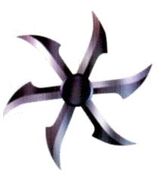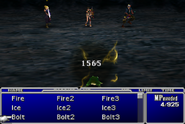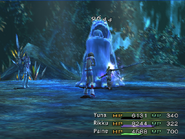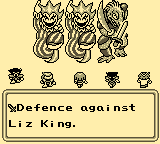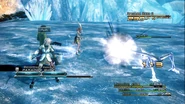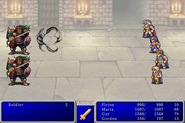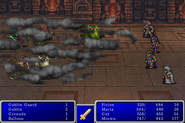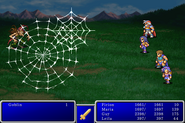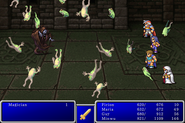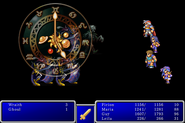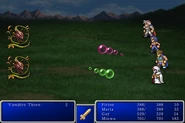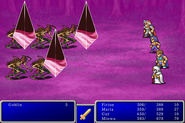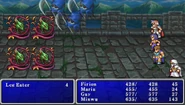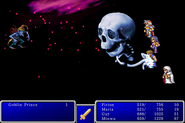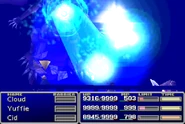
The party uses Fire magic against an opponent weak to the Fire element, dealing increased damage, in Final Fantasy: The 4 Heroes of Light.
Fire, ice, and lightning are the three principle elements. They are represented by the spells Fire, Blizzard, and Thunder, respectively.
Scholar in Advanced Battle Tactics
Elements (属性, Zokusei?) are special properties assigned to abilities, equipment, and even combatants that reflect their nature or natural affinities. They are present in almost every Final Fantasy game. Characters and monsters may be weak to, resistant to, immune to, or absorb these special properties.
Elements are often based on aspects of the natural world, such as fire, ice, lightning, or water, but may also be based on more abstract concepts, such as divine power. Many elements also exist to describe the manner in which an attack strikes its target, such as cutting, piercing, or blunt force attacks.
Elements play an important role during battle. They hold sway the survival of player characters against certain enemies. Manipulating elements often times mean life or death. The most commonly-recurring elements are Fire, Ice, Lightning, Wind, Earth, Water, Holy, and Dark. Many of these elements have a recurring summon based around them.
Most games feature Fire, Ice, and Lightning being in a trinity of sorts, although occasionally a fourth element will be added to expand the central set, such as Poison, or Water. Each of these primary elements generally has three or four levels of magic associated with it, although some games may have as many levels of magic for additional elements as well. Some games, notably Final Fantasy IV and Final Fantasy X, have fewer than eight elements. Final Fantasy IV does not feature a Water element; although several abilities, such as Flood and Tsunami, have water-based visual effects, these abilities are all either Ice-elemental or non-elemental, though they became Water-elemental when the element was featured in the 3D remake. Final Fantasy X, meanwhile, does not feature Earth, Wind, or Dark elements.
Elements[]
Recurring[]
Fire[]
One of the three standard elements. Most plant or undead enemies are weak against it, as well as beasts. Fire and Flare are the standard magics associated with the element. Fire-based attacks are usually shown to be effective against Ice-based enemies, most notably in Final Fantasy X where Fire and Ice are opposed, though Fire may sometimes be opposed to Water instead.
Ifrit and Phoenix are the prominent recurring summons of the fire element. In addition, Belias serves as the recurring fire-elemental summons in Ivalice titles, while Brynhildr serves a similar role in the Final Fantasy XIII subseries.
Ice[]
Ice is one of the three standard elements, and is easily defeated with Fire, and vice versa. Blizzard is its standard spell, while Freeze serves as the strongest form. Ice spells are typically effective against Fire-based enemies, particularly in Final Fantasy X, in which the Ice and Fire elements are diametrically opposed, while in Final Fantasy XII, Ice-based attacks are effective against enemies with Lightning affinities. In Final Fantasy IV, Ice spells are effective against reptiles and amphibians.
Shiva is the sole recurring summon representing this element. In Ivalice, the recurring summon of ice is Mateus.
Lightning[]
Lightning is also one of the three standard elements. Thunder is lightning's most basic spell, while Burst serves as the strongest form of lightning magic. Machines are known to be damaged greatly when struck with lightning-based attacks, but, depending on the game, could sometimes greatly absorb it. Lightning is often effective against water-based monsters, as is the case in Final Fantasy X. In Final Fantasy XII, lightning-based attacks are effective against ice-based enemies. While Lightning is typically effective against aquatic enemies, many games have a few lightning-using aquatic enemies which absorb the element instead.
Ramuh and Ixion are often the recurring summons for this element. Several subseries have featured their own unique lightning summons as well; Adrammelech serving the role in Ivalice titles, while Odin being the lightning Eidolon in the Final Fantasy XIII subseries.
Water[]
All Water-based enemies will absorb this element. Water is the basic elemental spell for this element, while Flood serves as the strongest spell of the element. Fire-based enemies are greatly affected by this element. In Final Fantasy X, wherein Water-based attacks are very effective against Lightning-based enemies.
Leviathan, Bismarck, and Siren are often the recurring summons for this element. In Ivalice, the recurring summon of water is Famfrit.
Earth[]
Earth-based attacks manipulate the ground, and will usually not affect airborne enemies or those imbued with the Float status. Most plant enemies absorb the earth element. Stone is the standard three tier magic carrying this element, with Quake being the recurring strongest form that attacks multple targets. However, Final Fantasy VII also features three levels of Quake spells.
Cactuar, Brothers, Golem, Hecatoncheir, Midgardsormr, and Titan are several recurring summons associated with this element. In Ivalice, the recurring summon of earth is Hashmal.
Wind[]
Wind-elemental attacks are often effective against aerial enemies, though in some games, aerial enemies may absorb them. Earth-based enemies are usually weak against this element. Aero and Tornado are some of the spells that belong to this element.
The recurring summons for this element include Fenrir, Garuda, Sylph, Typhon, and Valefor. In Ivalice, the recurring summon of wind is Chaos.
Holy[]
Holy, also known as Light, is a higher level element. The spells Banish and Dia serve as the recurring three tier holy magics in titles, with Holy serving as the strongest recurring offensive spell of this element. Undead and dark-based enemies tend to be susceptible to holy attacks. Undead enemies are also often damaged by healing spells such as Cure, which are sometimes considered holy-elemental. A notable exception is the first Final Fantasy, in which the Dia spell line is used.
In Final Fantasy IV, several weapons, including most of Cecil's Paladin swords and Kain's Holy Lance, are holy-elemental.
Alexander is the most recurring summon for this element, with Carbuncle, Lakshmi, and Madeen also appearing as secondary recurring holy summons. In Ivalice, the recurring summon of holy is Ultima.
Dark[]
Dark, also known as Shadow, is another higher level element. Since Final Fantasy XII, Dark has become a more prominent element in titles. The Dark spells serve as the recurring three tier magics for the element, with no recurring powerful form. The Dark Knight ability, Darkness, has served as a recurring dark-elemental ability in the series since its initial appearance in Final Fantasy IV. All of these abilities are very effective against Holy-based enemies, but most undead monsters are resistant to the dark element.
Several titles have also featured Dark Sword weapons to obtain, being dark-elemental and often used by Dark Knights.
Some recurring summons of the dark element include Anima, Diabolos, Fenrir, and Hades. Zodiark sometimes serves as the dark-elemental summon in titles set in Ivalice.
Poison[]
Poison is an element present in several main entries and spin-off titles. Bio serves as the recurring three tier poison magics in titles, with Scourge and Poison sometimes being aligned with the element. Holy-elemental targets are sometimes weak against the poison element. When inflicted with the status ailment Poison, an undead or poison-elemental enemy will heal itself with an effect similar to Regen. In newer titles, the Poison element is sometimes replaced with with the Dark element.
Doomtrain from Final Fantasy VIII is the only recurring poison summon, later appearing in Final Fantasy Record Keeper as a poison-elemental Soul Break summon.
Restorative[]
Restorative is also sometimes considered an element, and usually associated with either healing or reviving abilities. Other times they are classified as Holy-elemental in some games, despite the Holy spell damaging enemies which Cure would heal.
Shoot[]
Shoot, also known as Throw, Projectile or Projec, is an element that is possessed by weapons, usually Bows but also throwing weapons such as shuriken. They are effective against aerial enemies.
Gravity[]
Gravity appears as an element in Final Fantasy VII, Before Crisis -Final Fantasy VII-, and Final Fantasy X-2, it is related to the spell Gravity, also known as Demi. These spells deal damage based on the target's current or maximum HP. The recurring summon Diabolos usually uses gravity-based attacks, although gravity doesn't always function as an element. In the Ivalice Alliance games, Zeromus is the Scion associated with the element of Gravity.
Physical[]
Physical is an element that appears in Final Fantasy XIII, Final Fantasy XIII-2, Lightning Returns: Final Fantasy XIII, Final Fantasy Mystic Quest and The Final Fantasy Legend subseries for the Game Boy and it was known as both Weapon and Damage. It is one of two basic elements in Final Fantasy XIII, the other being Magic. In the games that this element appears, all physical attacks fall under this element including all damage caused by weapons and special physical attack skills. Usually, the spell Protect can reduce the damage received from physical attacks.
Magic[]
An element exclusive to Final Fantasy XIII, Final Fantasy XIII-2, and Lightning Returns: Final Fantasy XIII, it is one of two basic elements alongside Physical. The Magic element applies to all spells which fall into categories such as Medic's restoration magic spells and Ravager's offensive magic spells. The spell that can reduce the damage received, as well as also reduces potency of received healing through magic, is Shell.
Game-specific[]
Dia[]
In the original NES versions, Dia is not programmed as an element. Instead, the Dia spells are scripted to check whether the target has the Undead type. If so, they deal non-elemental damage to the target; otherwise, they have no effect.
Dia is, however, listed as an elemental weakness in the Bestiary in some remakes, including Dawn of Souls.
Status[]
This element seems to be used by status-inflicting spells which don't fit into any other category, including the Sleep, Blind, Slow, Hold, Confuse, Sleepra, Slowra, Stun, Blind, Mute and Fear spells and various enemy abilities. Resistance is provided by the NulDeath and NulAll spells and Ribbons.
Poison/Stone[]
This element is used by abilities associated with poison and/or petrification, including the Scourge and Break spells and various enemy abilities. Resistance is provided by the NulAll spell, the Aegis Shield and Ribbons.
Time[]
This element is used by abilities associated with space and/or time, including the Stop and Warp spells and various enemy abilities. Resistance is provided by the NulAll spell, the Black Robe and Ribbons.
Body[]
An element exclusive to Final Fantasy II, and the rarest of the status elements. It involves movement of a character, and the spells Blind, Silence, Slow, and Stun all fall under this element.
Matter[]
An element exclusive to Final Fantasy II. It is primarily the element of instant death attacks, with the exception of the Death spell itself. Besides Death, abilities that KO or change a character's form fall under this element such as Warp, Teleport, Mini, Toad, Break as well as Swap and Stop. All Undead enemies are immune to this element.
Mind[]
An element that appears in Final Fantasy I and Final Fantasy II, which was named in the Final Fantasy Origins release. Mind element attacks involve manipulation of the mind, includes Sap, Sleep, Fear, Fog, Confuse, and Curse. Many status abilities in the game fall under this element.
In Pixel Remaster, this element was renamed to Spirit in Final Fantasy I and Spectral in Final Fantasy II.
Death[]
An element exclusive to Final Fantasy and Final Fantasy II. It contains only one spell, Death. This limits the spell's effectiveness in battle, as enemies will often be immune to the Death element.
Comet[]
Comet appears as an element in Before Crisis -Final Fantasy VII-. The eponymous spell is usually a non-elemental attack in the Final Fantasy series, but the damage dealt to certain enemies through Comet and Cometeo in Before Crisis is unrelated to the damage dealt by other non-elemental attacks. Notably, the Typhon summon is Comet-elemental.
Hidden[]
Hidden is an element exclusive to Final Fantasy VII. It does not have much of an explanation, and only applies to a handful of Enemy Attacks and Aeris's Limit Breaks. By junctioning an Elemental Materia with a regular Materia (one that does not have a normal Elemental property), Hidden elemental attacks can be absorbed.
Drain[]
An element exclusive to Final Fantasy Mystic Quest, there are only three enemy abilities possessing this element. There is also an unused special protection related to drain, called Reverse Drain.
Axe[]
An element exclusive to Final Fantasy Mystic Quest. Benjamin and Kaeli's axes have this element, so does Reuben's Morning Star. Useful against the tree-type, crab-type, turtle-type and worm-type monsters.
Bomb[]
An element exclusive to Final Fantasy Mystic Quest. Benjamin's Bombs have this element. Only two types of enemies have this weakness: Gather-type and slime-type monsters.
Spacetime[]
An element exclusive to Final Fantasy Crystal Chronicles: Echoes of Time.
The spells Slow and Gravity possess this element. It can be boosted by equipping the Violet Essence bonus on a piece of equipment.
Stun[]
An element exclusive to Final Fantasy Crystal Chronicles: Echoes of Time.
The spell Quake and a Lilty's Hammer/Spoon attack possess this element. It can be boosted by equipping the Siver Essence bonus on a piece of equipment. This will increase the chance of stunning an enemy.
Jump[]
In Final Fantasy Record Keeper, most Dragoon abilities and some Soul Breaks are classed as jump attacks. Certain Record Materia specifically affect damage of jump attacks, and some bosses are specially affected by jump attacks. Most versions of Garuda (Final Fantasy III) take extra damage from jump attacks, while Barbariccia's tornado form is broken by jump attacks. The battle against the Demon Wall (Final Fantasy XII) guarding the Crushdown Nightmare Record prevents jump abilities and Soul Breaks from being used.
Etymology[]
Classical elements typically refer to ancient concepts similar to the modern states of matter: earth (solid), water (liquid), air (gas) and fire (plasma). Classical elements are the simplest form of existence, of everything in existence. Many philosophies and worldviews believe in classical elements.


